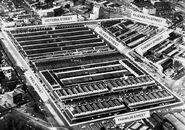The Queen Victoria Market (also known as the Queen Vic Markets or the Queen Vic, and locally as '"Vic Market"') is a major landmark in Melbourne and at around seven hectares (17 acres). The Market is significant to Melbourne's culture and heritage and has been listed on the Victorian Heritage Register.
The Queen Victoria Market is the only surviving 19th century market in the Melbourne central business district. There were once three major markets in the Melbourne CBD, but two of them, the Eastern Market and Western Market, both opened before the Queen Victoria, closed in the 1960s.
History[]
Starting as a small market to the east of the city in the 1850s, it gradually expanded into space made available by the closure of the old Melbourne Cemetery west of Queen Street and north of Franklin Street. The reinterment of human remains from the closure of the cemetery caused a great deal of controversy at the time. As there were about 10,000 burials on the site, there still remain approximately 9,000 people buried under the sheds and car park of the Queen Victoria Market. Every time work is carried out at the market, bones are disturbed. A memorial to these people stands on the corner of Queen Street and Therry Street. The Queen Victoria Market was officially opened on 20 March 1878. The Market was originally wholesale and retail fruit and vegetables, but has been retail since the wholesale market in Footscray Road was opened in 1969.
Attempts to close the market in the early 1970s were scuttled by bans conducted by the Builder Labourers' Federation and community groups.
The market was once known as a thriving underground pirated goods centre. A massive crackdown in 1997 has helped to clean up the market's image, but has also resulted in an increase in prices for these types of goods.
In 2003, the roofs of the market were equipped with 1,328 solar photovoltaic panels, covering 2000 square metres and generating 252,000 kilowatt-hours of electricity each year, the largest such renewable energy installation in the City of Melbourne. The grid has been considered as the largest urban grid-connected solar photovoltaic installation in the Southern Hemisphere upon completion.
The Market Today[]
Today, the Market is a major Melbourne tourist destination, offering a variety of fruit and vegetables, meat, poultry and seafood, gourmet and deli foods as well as specialty delicacies. It also has a large non-food related market, selling a diverse range of clothing, shoes, jewellery and handmade art and crafts.
The market is also known for the hot doughnut van which has operated for over half a century and become part of local tradition, being known for its jam donuts.
The Market is open every day of the week except Mondays and Wednesdays. On Wednesday evenings in the summer months, there is a night market which offers dining, bars, live entertainment and a variety of other stalls.
In January 2010, the Herald Sun reported that city planners wanted to transform the market into a "gourmet hub" by introducing upmarket food stalls.Lord Mayor Robert Doyle said he brought up the idea after visiting London's Borough Market, which has a "boutique" feel that could work in Melbourne.
$80.64 million for investment in the Queen Victoria Market in May 2015 as part of the City of Melbourne's draft 2015-2016 budget.
On June 12, 2015 Lord Mayor Robert Doyle and Environment Minister Greg Hunt announced the beginning of the process to place the Market on the UNESCO world heritage site.
The Queen Victoria Market's Twitter account is @VicMarket, and it is used to primarily promote events that occur there such as the Melbourne BBQ Festival and Night Markets.
Gallery[]
Trivia[]
- The Market is named after Queen Victoria who ruled the British Empire, from 1837 to 1901.
- The Market is the largest open air market in the Southern Hemisphere.



